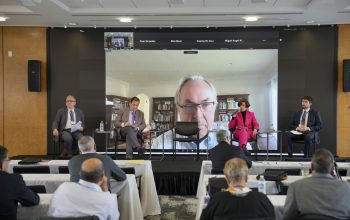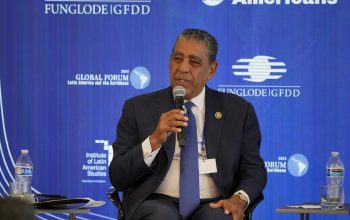news
“Obama’s Marc Antony–Style Remarks to the People of Cuba”, an article by Dr. Leonel Fernández
April 4, 2016
President Barack Obama’s recent speech in Havana, Cuba, was an intelligent, diplomatic, and elegant piece of discourse that showcased – to put it almost as he did in the title of his own book – the audacity of daring.
In preparing this speech, Obama faced a particular dilemma. On one side, if he appeared overly cautious in his phrasing, he risked the U.S. conservative right slating his visit to the Caribbean island as a move
that legitimized a dictatorship. On the other side, if his comments went too far, he might arouse suspicion of the Cuban authorities that he had come to the country with the seditious intent to instigate a public uprising.
To resolve this dilemma, President Obama deployed a series of persuasive techniques ranging from storytelling, that is, using narrative with literary overtones, to speaking in a conciliatory tone with the intent to avoid discrepancies, as well as
rhetorical devices that allowed him to subtly elaborate on conflicting judgments ranging from praise to concealed criticism.
Marc Antony’s Speech
He managed all this by taking as a model, whether consciously or intuitively, Marc Antony’s eulogy before Julius Caesar’s lifeless body, as popularized by William Shakespeare in his eponymous play about the Roman emperor.
Indeed, after Caesar is
stabbed by Cassius and Brutus, Marc Antony, carrying the body in his arms, appears before the people of Rome gathered at the Forum and intones:
Friends, Romans, countrymen, lend me your ears;
I come to bury Caesar, not to praise him.
The evil that men do lives after them;
The good is oft interred with their bones;
So let it be with Caesar.
The noble Brutus
Hath
told you Caesar was ambitious:
If it were so, it was a grievous fault,
And grievously hath Caesar answer’d it.
Here, under leave of Brutus and the rest–
For Brutus is an honourable man;
So are they all, all honourable men–
Come I to speak in Caesar’s funeral.
He was my friend, faithful and just to me:
But Brutus says he was ambitious;
And Brutus is an honourable man.
He hath brought many captives home to Rome
Whose ransoms did the general coffers fill:
Did this in Caesar seem ambitious?
When that the poor have cried, Caesar hath wept:
Ambition should be made of sterner stuff:
Yet Brutus says he was ambitious;
And Brutus is an honourable man.
You all did see that…I
thrice presented him a kingly crown,
Which he did thrice refuse: was this ambition?
Yet Brutus says he was ambitious;
And, sure, he is an honourable man.
I speak not to disprove what Brutus spoke,
But here I am to speak what I do know.
By the end of the speech Marc Antony – who at first faced a hostile audience – had used nothing but the art of persuasion to reverse
the attitude of those congregated and rouse the people of Rome against Caesar’s assassins, Cassius and Brutus.
To pull this off, Marc Antony avoided contradicting Brutus, who initially was perceived as a hero. He attempted to adjust his style to suit his audience. He used a conciliatory tone. He employed the technique of apparent courtesy. He reinforced his position using irony and thereby persuaded the people, unaware of the shift, to rise up against
Caesar’s murderers.
Marc Antony’s speech was simply dazzling, and still remains one of the most notable pieces of oratory in the history of the world.
Obama’s Strategy
When we look at Barack Obama’s oratorical piece in Cuba, we can clearly see his use of techniques analogous to those of the Roman tribune. In his speech, the US head of states weaves a distinction between the
government and the people, the state and individual, the past and the future, and young people and history, which – couched in constant appeals to the notion of hope – aimed to raise the expectations of the Cuban people regarding the transformation of their current economic, social, and political order.
Nonetheless, he does this with subtlety and perspicacity. He begins by recalling, in Spanish, the only figure capable of uniting all Cubans – the
Apostle of Independence, José Martí – and does so by foregrounding that revolutionary’s great poetic tribute to friendship, “Cultivo una rosa blanca” (“I Have a White Rose to Tend”).
With that the young African American head of state, with enormous elegance, thanks his hosts for the hospitality shown to him and his wife and two daughters and offers greetings of peace from the US government to
the Cuban people.
He then moves on, after referencing the history and geography shared by both nations, to the purpose of the visit and personal references related to the evolution of Cuba’s modern history.
He builds his arguments on the commonalities and shared values between Cuba and the United States. He speaks of the normalization of relations, of issues still pending on the bilateral agenda such as
lifting the embargo and shutting down the US naval base at Guantánamo, and praises both the talent of the Cuban people and the social policies of their government.
But he likewise highlights and emphasizes the differences; he appeals to young people for a vision of the future, and although he insists the United States will impose no changes on Cuba, he hints at such changes, and almost subliminally incites the Cuban people to push for their
crystallization.
He cunningly makes an effort to distinguish between old and new, the anachronistic and the modern, and in doing so he offers himself as a point of reference:
“Like so many people in both of our countries, my lifetime has spanned a time of isolation between us. The Cuban Revolution took place the same year that my father came to the United States from Kenya. The Bay of Pigs took place the year that I was
born.”
Style and Substance
The message is obvious. Using an apparently respectful and measured but simultaneously daring style, president Obama is making clear that the Cuban revolution is a vestige of the past, frozen in time.
Despite this, he solemnly announces the purpose of his visit, proclaiming:
“I have come here to bury the last remnant of the Cold War in the Americas. I have come
here to extend the hand of friendship to the Cuban people.”
Although further on he notes that what matters is what the people of both nations hold in common, in the spheres of science, letters, sports, music, gastronomy, and faith, he leaves no doubt that substantial differences exist with regard to their respective governments, economies, and societies.
He explicitly mentions that while Cuba has a one-party system, the United States is a
multiparty democracy; while Cuba espouses a socialist economic model, the United States has opted for a free market one; while Cuba has bolstered the role and rights of the state, the United States is founded on individual rights. Faced with that reality, he argues cleverly, the United States has neither the capacity nor the intention to impose changes: what changes in Cuba, he says, will depend on Cuban people themselves.
But these changes, according to his own beliefs
and those of the American people, should relate to the fact that “citizens should be free to speak their mind without fear, to organize, and to criticize their government, and to protest peacefully, and … the rule of law should not include arbitrary detentions of people who exercise those rights. And, yes, I believe voters should be able to choose their governments in free and fair elections.”
Under other circumstances that final statement, spoken
before Cuba’s highest authorities, would have appeared not just imprudent but also rude and shocking. Nonetheless, with great astuteness, he admits that not everyone will agree with him, and immediately, to establish a certain equilibrium and lend credibility to his words, he criticizes the workings of the United States’ own democracy.
From the perspective of their content, president Barack Obama’s remarks to the Cuban people were an attempt
to strike a verbal balance between audacity and restraint. In the end, as could have been predicted, he received a critique from Ted Cruz from the right, and a rebuttal from Fidel Castro himself from the left.
From the perspective of rhetorical form, it was a calculated and daring piece, a sort of modern version of Marc Antony’s funeral oration before the inert body of Julius Caesar.
Related Link: http://leonelfernandez.com/articulos/el-discurso-de-obama-al-estilo-de-marco-antonio/






